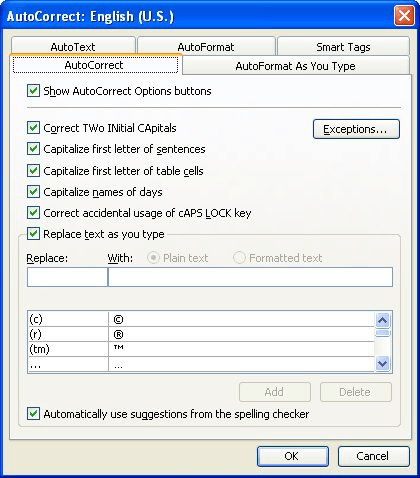Please Note: This article is written for users of the following Microsoft Word versions: 97, 2000, 2002, and 2003. If you are using a later version (Word 2007 or later), this tip may not work for you. For a version of this tip written specifically for later versions of Word, click here: Turning Off Capital Corrections.
Written by Allen Wyatt (last updated March 18, 2023)
This tip applies to Word 97, 2000, 2002, and 2003
Word tries its level best to be a good guesser at what you are trying to do. For instance, as you are typing along, if you type a word where the first two letters are uppercase, and the next letter is lowercase, Word will figure you just have slow fingers and didn't release the Shift key in time to make the second letter lowercase. So, it dutifully changes the second letter to lowercase to help you out. For instance, the word PLace becomes Place.
There are some situations where this behavior can be bothersome, however. For instance, you may have a company or product name in which the first two letters are always capitalized, such as INtec or MYphone. In these cases, Word also tries to do its magic and change the capitalization, which can cause no end to proofreading passes and related problems.
One solution to this problem is to turn off the correction that Word does to your words. (At least for this particular capitalization issue.) Here's how you do it:

Figure 1. The AutoCorrect tab of the AutoCorrect dialog box.
WordTips is your source for cost-effective Microsoft Word training. (Microsoft Word is the most popular word processing software in the world.) This tip (481) applies to Microsoft Word 97, 2000, 2002, and 2003. You can find a version of this tip for the ribbon interface of Word (Word 2007 and later) here: Turning Off Capital Corrections.

Discover the Power of Microsoft Office This beginner-friendly guide reveals the expert tips and strategies you need to skyrocket your productivity and use Office 365 like a pro. Mastering software like Word, Excel, and PowerPoint is essential to be more efficient and advance your career. Simple lessons guide you through every step, providing the knowledge you need to get started. Check out Microsoft Office 365 For Beginners today!
When automatically capitalizing the beginning of sentences, Word relies on how you historically have done your typing. ...
Discover MoreThe AutoCorrect feature in Word is quite handy, but getting a lot of entries into the feature can be tedious. This tip ...
Discover MoreSection marks are used regularly in the writings of some industries, such as in legal documents. If you need a way to ...
Discover MoreFREE SERVICE: Get tips like this every week in WordTips, a free productivity newsletter. Enter your address and click "Subscribe."
There are currently no comments for this tip. (Be the first to leave your comment—just use the simple form above!)
Got a version of Word that uses the menu interface (Word 97, Word 2000, Word 2002, or Word 2003)? This site is for you! If you use a later version of Word, visit our WordTips site focusing on the ribbon interface.
Visit the WordTips channel on YouTube
FREE SERVICE: Get tips like this every week in WordTips, a free productivity newsletter. Enter your address and click "Subscribe."
Copyright © 2026 Sharon Parq Associates, Inc.
Comments